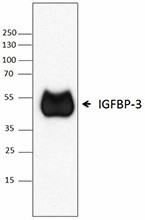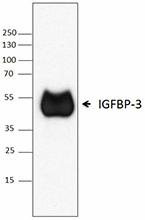- Clone
- M6501G03 (See other available formats)
- Regulatory Status
- RUO
- Other Names
- Insulin-like growth factor binding protein 3, IGF-Binding Protein 3, Growth Hormone-Dependent Binding Protein, Binding Protein 29, IBP3, BP-53, IGFBP3
- Isotype
- Mouse IgG1, κ
- Ave. Rating
- Submit a Review
- Product Citations
- publications

-
Western blot analysis of recombinant human IGFBP-3. Anti-IGFBP-3 antibody (clone M6501G03) was used, followed by HRP anti-mouse IgG antibody.
The insulin-like growth factor system includes two receptors (IGF-1R and IGF-2R), two ligands (IGF-1 and IGF-2), and seven binding proteins (IGFBP1-7). The binding proteins are produced in the liver and bind to the IGFs with different affinities, thus regulating the interaction of the IGFs with their receptors. Insulin-like growth factor binding protein-3 (IGFBP-3) is the major serum carrier protein for IGF proteins. IGFBP-3 sequesters IGF in a stable ternary complex with the acid-labile subunit (ALS). IGFBP-3 binds IGF-1 with high affinity and specificity and modulates IGF-1 action. IGFBP-3 undergoes limited enzymatic proteolysis to generate small N-terminal fragments. These proteolytic products lose their affinity for IGF-1 and IGF-2. Nevertheless, they preserve IGF independent activity. In that sense, a 16 kD fragment (1-95-IGFBP-3) and the full length molecule can potentiate apoptosis in colorectal epithelial cells, and this apoptotic process is associated with the inhibition of TNF-α-induced NF-κB activity. In addition, IGFBP-3 has been detected in the cell nucleus and interacts with 9-cis retinoic acid receptor-alpha (RXR-α), which is a nuclear receptor that is required for the apoptosis-inducing effects of IGFBP-3. IGFBP-3R physically interacts and activates caspase-8 and mediates IGFBP-3-induced apoptosis and tumor suppression.
Product DetailsProduct Details
- Verified Reactivity
- Human
- Antibody Type
- Monoclonal
- Host Species
- Mouse
- Immunogen
- Human IGFBP-3, amino acids (Gly28-Glu291) (Accession# X64875) with an N-terminal Met, was expressed in 293E cells.
- Formulation
- Phosphate-buffered solution, pH 7.2, containing 0.09% sodium azide.
- Preparation
- The antibody was purified by affinity chromatography.
- Concentration
- 0.5 mg/ml
- Storage & Handling
- The antibody solution should be stored undiluted between 2°C and 8°C.
- Application
-
WB - Quality tested
- Recommended Usage
-
Each lot of this antibody is quality control tested by Western blotting. For Western blotting, the suggested use of this reagent is 0.5 - 2.0 µg per ml. It is recommended that the reagent be titrated for optimal performance for each application.
- RRID
-
AB_2566243 (BioLegend Cat. No. 679702)
Antigen Details
- Structure
- 291 amino acids with a predicted molecular weight of approximately 32 kD. The glycosylated form migrates at approximately 45-50 kD by SDS-PAGE.
- Distribution
-
IGFBP-3 is expressed by most of the tissues and is present in plasma.
- Function
- Transports insulin like growth factors (IGFs) and protects them from rapid clearance and/or degradation as well as modulating IGFs bioavailability. IGFBP-3 induces apoptosis in vitro and suppresses tumors in vivo. IGFBP-3 is induced by growth hormones, TGF-β, vitamin D, retinoids, and anti-estrogens.
- Interaction
- Interacts with XLKD1, IGF2, IGF1, ALS, HN, and TMEM219.
- Ligand/Receptor
- IGFBP-3R (TMEM219).
- Biology Area
- Apoptosis/Tumor Suppressors/Cell Death, Cell Biology, Cell Cycle/DNA Replication, Signal Transduction
- Antigen References
-
1. Cohen P, et al. 1992. J. Clin. Endocrinol. Metab. 75:1046.
2. Lee KW and Cohen P. 2002. J. Endocrinol. 175:33.
3. Yan X, et al. 2004. J. Biol. Chem. 279:53232.
4. Shahjee H, et al. 2008. Growth Horm. IGF Res. 18:188-97.
5. Berrigan D, et al. 2009. Growth Horm. IGF Res. 2:146.
6. Ingermann AR, et al. 2010. J. Biol. Chem. 285:30233.
7. Forbes BE, et al. 2012. Front. Endocrinol. 3:38.
8. Baxter RC, et al. 2014. Nat. Rev. Cancer 14:329. - Gene ID
- 3486 View all products for this Gene ID
- UniProt
- View information about IGFBP-3 on UniProt.org
Related Pages & Pathways
Pages
Related FAQs
Other Formats
View All IGFBP-3 Reagents Request Custom Conjugation| Description | Clone | Applications |
|---|---|---|
| Purified anti-IGFBP-3 | M6501G03 | WB |
Compare Data Across All Formats
This data display is provided for general comparisons between formats.
Your actual data may vary due to variations in samples, target cells, instruments and their settings, staining conditions, and other factors.
If you need assistance with selecting the best format contact our expert technical support team.
-
Purified anti-IGFBP-3
Western blot analysis of recombinant human IGFBP-3. Anti-IGF...









Follow Us